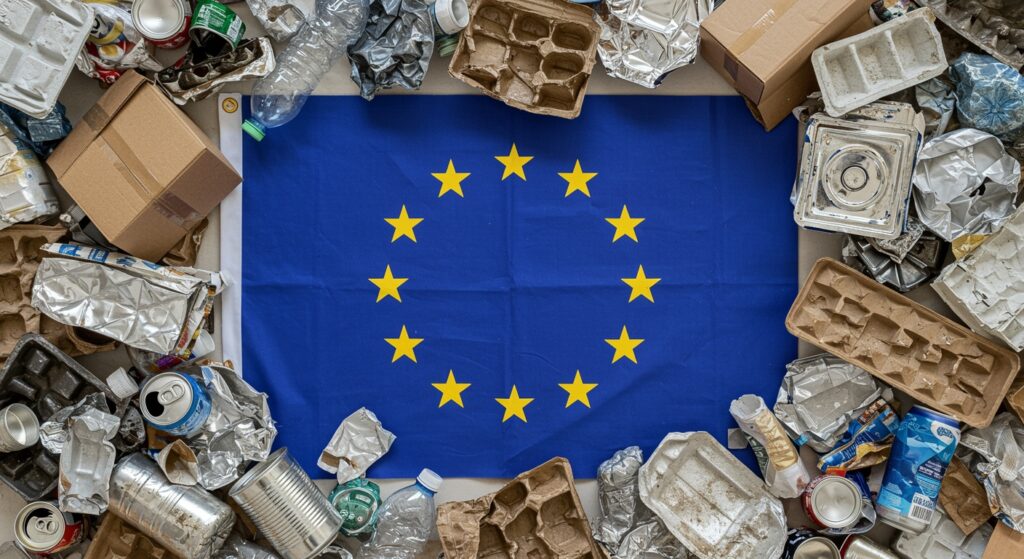The European Union faces major challenges in meeting packaging waste reduction targets by 2030.
Coupled with inadequate recycling infrastructure, the growing demand for convenience complicates block-wide waste management efforts.
Many packaging materials remain difficult to recycle, and are then in large quantities of landfills or incinerated.
While some EU countries are making progress through innovative policies and practices, understanding the broader challenges is essential to assess the EU’s path to circular economy and more effective regulation.
Why Europe produces more plastic waste than ever
The rise in plastic waste across Europe comes from several interconnected factors. In 2022, the EU produced an average of 186.5 kg of packaging waste per person, with 36 kg being attributed to plastic alone.
The growing preference for convenience-driven products, especially those relying on disposable plastics, has contributed greatly to this rise.
Recycling technology is advancing, but it has not met the rapid growth in waste production.
Insufficient recycling infrastructure and fragmented waste management systems only exacerbated the problem. As a result, landfills continue to overflow and environmental pollution continues.
In response, the EU has introduced regulations aimed at ensuring 100% recyclable packaging by 2030. However, adjusting standards in all member states remains an important obstacle to achieving these ambitious goals.
How Online Shopping and Takeout Culture is Advancing Packaged Waste
The boom in e-commerce and take-out services has played a major role in escalating packaging waste.
The excessive use of materials such as multi-layer packaging and oversized boxes has become a common practice in online retail.
To address this, new EU regulations have introduced a maximum empty space threshold of 50% for grouped packages and e-commerce packages. These efforts aim to reduce the use of unnecessary materials without compromising the safety of products in transit.
Furthermore, to address the rise in waste from takeout culture, the EU has pledged to reduce package waste by 10% by 2035 and 15% by 2040.
As part of this strategy, the ban on certain single-use plastic packaging commonly used in take-out services will take effect on January 1, 2030. This represents a crucial step towards reducing waste and promoting more sustainable consumption.
Why most packaging is still in landfills and incinerators
Despite improvements in recycling technology, a significant share of packaging waste continues to be landfilled or incinerated.
The main reasons are as follows:
Effects of factors on the complex material composition of packaging waste Insufficient recycling facilities lead to increased consumer behavior in landfills and incineration, and shortage of a reduction in the shortage of waste waste.
The EU set a target for 100% recyclable packaging by 2030, but current practices remain inconsistent with this vision. Overcoming sustainable barriers requires more cohesive strategies and enforcement mechanisms.
Which countries are leading the way in reducing waste?
Several European countries have emerged as the forefront in the transition to sustainable packaging. Their policies and innovations serve as potential blueprints for the rest of the EU.
Germany: Recycling rates of around 67% in 2021, well above the EU average. Netherlands: We have introduced a mineral return system for plastic bottles and cans, resulting in a recycling rate of over 90% of these items. Sweden: By 2025, strict regulations on single-use plastics targeting 100% recyclable or reusable packaging have been implemented. France: Prohibits several types of single-use plastic, promotes reusable alternatives, achieving a 15% reduction in plastic packaging waste since 2018.
These examples show that ambitious regulations and public engagement combine to help reduce packaging waste and support broader EU sustainability goals.
How packaging waste threatens the transition to Europe’s circular economy
Reduction of packaging waste is central to the EU’s circular economy goals. However, current trends suggest that by 2030 it may be difficult to reduce packaging waste by 5%.
In 2022, plastic packaging played a substantial role, with average waste still high. Packaging and Packaging Waste Regulation (PPWR) requires that all packaging be recyclable by 2030, but this goal is undermined by low recycling rates and limited incorporation of reusable systems.
Resistance is also from industries that rely on single-use plastics. Furthermore, achieving a 10% market share target for reusable packaging by 2030 poses logistical and cultural challenges.
Unless critical and coordinated action is taken, packaging waste can hinder the EU’s transition to a circular economy and undermine progress towards climate neutrality and resource efficiency.
How PPWR aims to resolve the crisis
PPWR is the foundation of the EU’s strategy to tackle the growing packaging waste crisis. Here is a comprehensive framework focusing on sustainability and circularity, including:
Binding Reduction Target: Based on the 2018 level, the aim is to reduce packaging waste by 5% by 2030. Essential Recyclability: All packages placed in the EU market must be fully recyclable by 2030. Recycled Content Requirements: Requires at least 30% recycled content in plastic packaging by 2030, increasing by 2040.
When implemented effectively, these measures can significantly reduce packaging waste and advance Europe’s broader sustainability and circular economy ambitions.
Source link

